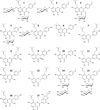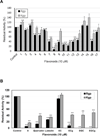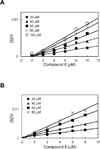Inhibition of gingipains and Porphyromonas gingivalis growth and biofilm formation by prenyl flavonoids
- PMID: 26957413
- PMCID: PMC5199630
- DOI: 10.1111/jre.12372
Inhibition of gingipains and Porphyromonas gingivalis growth and biofilm formation by prenyl flavonoids
Abstract
Background and objective: Porphyromonas gingivalis is considered a major pathogen of chronic periodontitis, which also may be implicated with systemic diseases such as atherosclerosis. Secreted cysteine proteases, gingipains Rgp and Kgp, are essential for P. gingivalis virulence. Some polyphenols and flavonoids are known to inhibit gingipain activity and interfere with biofilm formation by P. gingivalis. Many bioactive compounds have been isolated from Epimedium species, but availability of these compounds on gingipains and P. gingivalis is still unclear. Therefore, the aim of this study was to evaluate natural products from medical plants to develop a new therapeutic agent against periodontal disease.
Material and methods: Prenylated flavonoids were isolated from Epimedium species plant using column chromatographies. The inhibitory effect of the prenylated flavonoids against protease activity of gingipains were examined using purified gingipains and fluorogenic substrates. Anti-P. gingivalis activity was evaluated to analyze planktonic growth and biofilm formation in brain heart infusion medium in the presence of the prenylated flavonoids.
Results: We isolated 17 prenylated flavonoids (Limonianin, Epimedokoreanin B, etc.) from Epimedium species. We found that some prenylated flavonoids inhibited gingipain activity in a non-competitive manner with Ki values at μm order. The prenylated flavonoids also hindered growth and biofilm formation of P. gingivalis, in a manner independent of gingipain inhibition by the compounds.
Conclusion: The results indicated an inhibitory effect of the prenylated flavonoids against P. gingivalis and would provide useful information for future development of periodontitis treatment that suppresses gingipains, P. gingivalis growth and biofilm formation.
Keywords: Porphyromonas gingivalis growth; biofilm; gingipains; prenylated flavonoids.
© 2016 John Wiley & Sons A/S. Published by John Wiley & Sons Ltd.
Figures




Similar articles
-
A natural anti-periodontitis agent, epimedokoreanin B, inhibits virulence activities of gingipains from Porphyromonas gingivalis.Biosci Biotechnol Biochem. 2019 Jul;83(7):1382-1384. doi: 10.1080/09168451.2019.1597615. Epub 2019 Mar 26. Biosci Biotechnol Biochem. 2019. PMID: 30912703
-
Role of Porphyromonas gingivalis gingipains in multi-species biofilm formation.BMC Microbiol. 2014 Oct 2;14:258. doi: 10.1186/s12866-014-0258-7. BMC Microbiol. 2014. PMID: 25270662 Free PMC article.
-
Limonium brasiliense rhizomes extract against virulence factors of Porphyromonas gingivalis: Inhibition of gingipains, bacterial adhesion, and biofilm formation.Fitoterapia. 2024 Sep;177:106120. doi: 10.1016/j.fitote.2024.106120. Epub 2024 Jul 9. Fitoterapia. 2024. PMID: 38992475
-
Discovery of Gingipains and Porphyromonas gingivalis Inhibitors from Food-Derived Natural Products: A Narrative Review.Foods. 2025 Aug 19;14(16):2869. doi: 10.3390/foods14162869. Foods. 2025. PMID: 40870784 Review.
-
Suppression of virulence of Porphyromonas gingivalis by potent inhibitors specific for gingipains.Curr Protein Pept Sci. 2003 Dec;4(6):451-8. doi: 10.2174/1389203033486992. Curr Protein Pept Sci. 2003. PMID: 14683430 Review.
Cited by
-
Implications of Porphyromonas gingivalis peptidyl arginine deiminase and gingipain R in human health and diseases.Front Cell Infect Microbiol. 2022 Sep 29;12:987683. doi: 10.3389/fcimb.2022.987683. eCollection 2022. Front Cell Infect Microbiol. 2022. PMID: 36250046 Free PMC article. Review.
-
Effect of curcumin on growth, biofilm formation and virulence factor gene expression of Porphyromonas gingivalis.Odontology. 2021 Jan;109(1):18-28. doi: 10.1007/s10266-020-00514-y. Epub 2020 Apr 11. Odontology. 2021. PMID: 32279229
-
High molecular weight hyaluronic acid reduces the growth and biofilm formation of the oral pathogen Porphyromonas gingivalis.Saudi Dent J. 2023 Feb;35(2):141-146. doi: 10.1016/j.sdentj.2023.01.008. Epub 2023 Feb 2. Saudi Dent J. 2023. PMID: 36942200 Free PMC article.
-
Polyphenols in Oral Health: Homeostasis Maintenance, Disease Prevention, and Therapeutic Applications.Nutrients. 2023 Oct 16;15(20):4384. doi: 10.3390/nu15204384. Nutrients. 2023. PMID: 37892459 Free PMC article. Review.
-
Antibacterial Modes of Herbal Flavonoids Combat Resistant Bacteria.Front Pharmacol. 2022 Jun 27;13:873374. doi: 10.3389/fphar.2022.873374. eCollection 2022. Front Pharmacol. 2022. PMID: 35847042 Free PMC article. Review.
References
-
- Slots J. Actinobacillus actinomycetemcomitans and Porphyromonas gingivalis in periodontal disease: introduction. Periodontol 2000. 1999;20:7–13. - PubMed
-
- Oliver RC, Brown LJ. Periodontal diseases and tooth loss. Periodontol 2000. 1993;2:117–127. - PubMed
-
- Imamura T. The role of gingipains in the pathogenesis of periodontal disease. J Periodontol. 2003;74:111–118. - PubMed
-
- NM OB-S, Veith PD, Dashper SG, Reynolds EC. Porphyromonas gingivalis gingipains: the molecular teeth of a microbial vampire. Curr Protein Pept Sci. 2003;4:409–426. - PubMed
-
- Potempa J, Sroka A, Imamura T, Travis J. Gingipains, the major cysteine proteinases and virulence factors of Porphyromonas gingivalis: structure, function and assembly of multidomain protein complexes. Current Protein and Peptide Science. 2003;4:397–407. - PubMed
MeSH terms
Substances
Grants and funding
LinkOut - more resources
Full Text Sources
Other Literature Sources
Molecular Biology Databases

